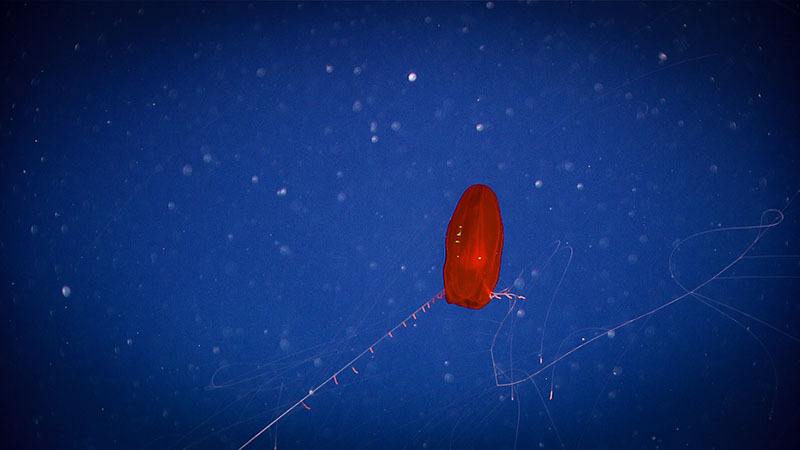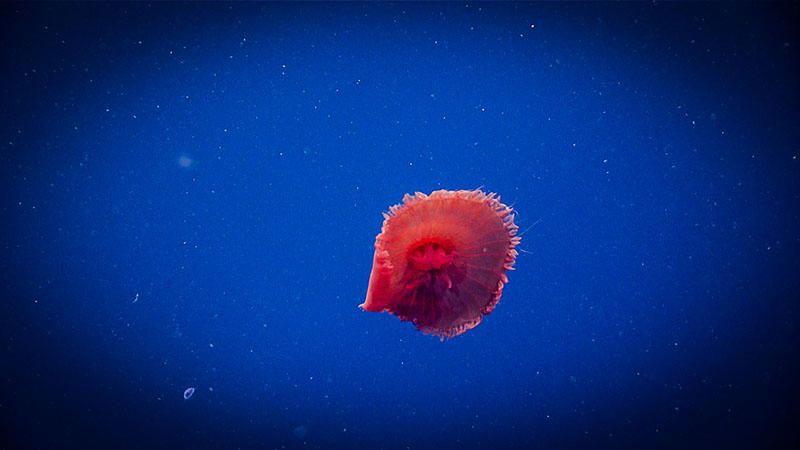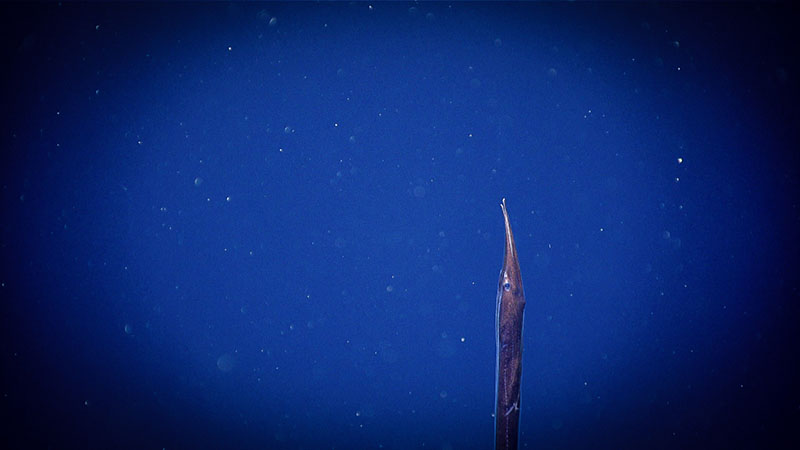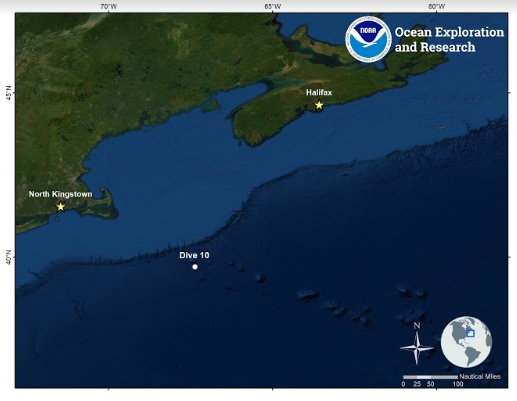
Date: September 11, 2019
Location: Lat: 39.99240°, Lon: -67.35045°
Dive Depth Range: 700 - 2,180 meters (2,298 - 7,157 feet)
Access Dive Summary and ROV Data
A multitude of midwater life, including a rattail fish, a hydromedusa, a sawtooth eel, a potentially undescribed ctenophore, a smelt, a red jelly, and a chimera are among the organisms seen during a midwater dive off of Bear Seamount, during Deep Connections 2019. Video courtesy of the NOAA Office of Ocean Exploration and Research, Deep Connections 2019. Download larger version (mp4, 65 MB).

A chimera seen swimming near the seafloor during the first midwater transect of Dive 10 of the Deep Connections 2019 expedition. Image courtesy of the NOAA Office of Ocean Exploration and Research, Deep Connections 2019. Download larger version (jpg, 1.2 MB).
Today marked our first midwater dive of the expedition, and we were fortunate to have various midwater specialists join us on the line from shore to help guide the dive. Our dive site was located just north of Bear Seamount, within the Northeast Canyons and Seamounts Marine National Monument. There have been extensive nekton trawling surveys in the vicinity of this site, as well as several remotely operated vehicle (ROV) dives that explored benthic habitats on Bear Seamount. However, there had been no previous midwater ROV dives on the seamount. This dive therefore sought to collect valuable midwater video data for comparisons to historic midwater trawl data.

This potentially undescribed cidippid ctenophore was seen floating gracefully in the water column during dive 10 of the Deep Connections 2019 expedition. Image courtesy of the NOAA Office of Ocean Exploration and Research, Deep Connections 2019. Download larger version (jpg, 1.5 MB).
We began this dive by descending towards the seafloor, at a depth of 2,182 meters (~7,159 feet) and performing two near bottom transects at 1.5 meters (~5 feet) and 10 meters (~33 feet) above the seafloor. Particulates in the water column were dense during these transects, and numerous larvacean houses were observed along with ctenophores, arrow worms, krill, hydromedusae, and copepods. A large chimera and juvenile rattail fish were also observed just above the seafloor. Between transects, a possibly new species of red cidippid ctenophore was collected using the suction sampler.

This dusky red jelly, Poralia sp., is a common sight during midwater transects. This image was captured during dive 10 of the Deep Connections 2019 expedition. Image courtesy of the NOAA Office of Ocean Exploration and Research, Deep Connections 2019. Download larger version (jpg, 1.4 MB).

This sawtooth eel was spotted floating vertically in the water column during dive 10 of Deep Connections 2019 expedition. This fish is unique in having teeth that are fused into a single band down the center of the roof of its mouth, like a saw. Image courtesy of the NOAA Office of Ocean Exploration and Research, Deep Connections 2019. Download larger version (jpg, 1.3 MB).
The ROV conducted midwater transects at 1100, 900, and 700 meters (~3609, 2953 and 2297 feet). Animals observed included bristlemouth fish, hydromedusae, krill, copepods, nemertea, jellyfish, siphonophores, sawtooth eel, lobate ctenophores, goiter blacksmelt, and pyrosomes. Midway through the 700 meter transect, surface currents picked up and approached 3 knots, too strong to safely conduct ROV operations. As a result, the transect was ended prematurely and the vehicles were recovered.

Location of Dive 10 of the Deep Connections 2019 expedition on September 11, 2019. Download (jpg, 122 KB).

Map showing the dive track of Dive 10 of the Deep Connections 2019 expedition. Scale is water depth in meters. Download larger version (jpg, 209 KB).